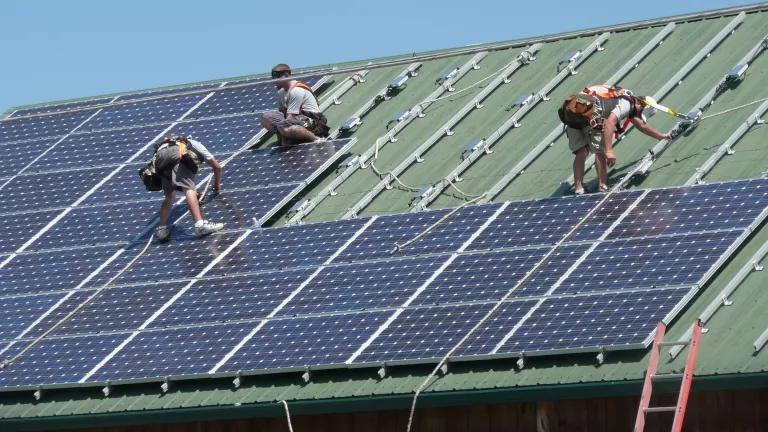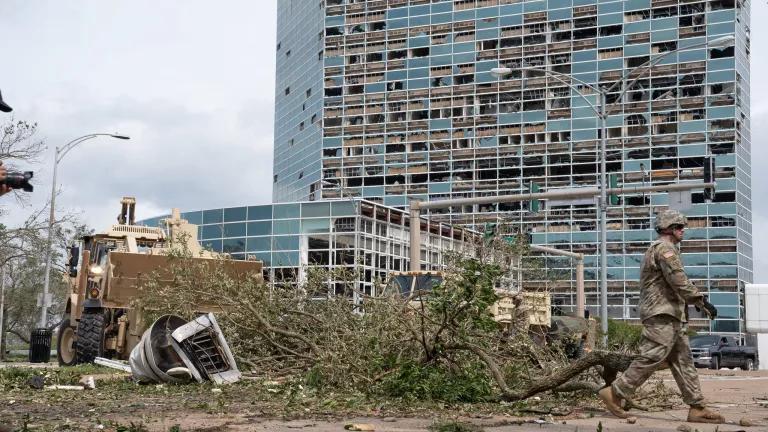Lowering Energy Costs and Emissions in Rural America
NRDC endorses legislation to improve USDA’s Rural Energy for America Program.

105 solar panels are installed at Littlestown Veterinary Hospital in Littlestown, PA, thanks to a grant from the USDA’s Rural Energy for America (REAP) Program. Solar power is expected to reduce the facility’s operating expenses by 30%-40%.
The Rural Energy for America Program (REAP) has been a stalwart program for rural America. The program, implemented by the U.S. Department of Agriculture, has provided cost-shared grants and loans to rural small businesses, farmers, and ranchers to install renewable energy systems, make energy efficiency upgrades, or buy efficient equipment and improve processing efficiency. Since the program’s inception in 2002, REAP has been a bipartisan success story, delivering more than $3.4 billion in energy efficiency and renewable energy projects for rural America since 2021 alone. To illustrate who the REAP program has helped and how, last year, the Environmental Law & Policy Center talked to people from around the country, who shared their own REAP success stories.
As with most programs that have been around for more than two decades, REAP is ripe for updates and improvements to meet the evolving challenges of our times. Recent surveys indicate that 88 percent of farmers under 40 attribute changes in weather patterns to climate change, and 73 percent of young farmers have experienced at least one climate impact on their farm in the past year. Given these realities, it’s crucial for REAP to evolve to more effectively address these emerging challenges. This is the driving force behind NRDC’s endorsement of the REAP Modernization Act, introduced by Senators Tina Smith and Ben Ray Luján and Representatives Abigail Spanberger and David Valadao, and the Rural Energy Equity Act, introduced by Senator Peter Welch.
REAP Modernization Act
The REAP Modernization Act offers numerous alterations to the statute to further the climate benefits of the program, reduce costs to consumers, streamline the application process, and more.
While the program has historically focused on the potential environmental benefits of projects, the REAP Modernization Act would add “climate benefits” as a new consideration. By adding climate benefits as a consideration, projects can be looked at holistically to ensure that emissions, air pollution, and water pollution are not worsened as a result of a REAP project.
The REAP Modernization Act would also help streamline the application process and further reduce the costs faced by rural small businesses, farmers, and ranchers. Currently, if a REAP applicant wants to understand more about their energy use and receive recommendations about how they can make their operation more efficient or use renewable energy to meet certain demands, the applicant would have to apply separately for both in different award cycles—requiring multiple applications over a longer duration of time. The REAP Modernization Act streamlines this process by allowing applicants to apply for both services, speeding up the process and reducing the wait time between energy audits and recommendations to save money.
Rural Energy Equity Act
The Rural Energy Equity Act takes a similar and complementary approach to the REAP Modernization Act in lowering costs and adding climate considerations for the program, but it also adds an important element of equity into the program.
Although small farms and businesses are eligible for funds under REAP, larger farming operations are also competing for the same, limited pot of funding. As can happen with federal funding opportunities, larger entities with more resources and expertise in applying for federal funds can dominate the application process. Adding to their resources and expertise, larger operations also offer an even greater potential to reduce energy costs and emissions, which are both considerations when making awards under REAP.
The Rural Energy Equity Act looks to level the playing field for small- and medium-size farms, as well as underserved, beginning, or veteran farmers and ranchers. To achieve this, the bill proposes increasing the cost share for grants to build renewable energy systems and make energy efficiency upgrades. Instead of being responsible for 75 percent of the cost of a project, as is currently the case, underserved, beginning, or veteran farmers would only be responsible for as much as 25 percent of the project cost. Further, the Rural Energy Equity Act would establish a new way of scoring successful applicants to increase the program utilization by small- and medium-size farmers, thus ensuring larger entities do not dominate the funding availability.
What comes next for REAP
Opportunities to improve REAP will come through the same legislative vehicle it originated from: the Farm Bill. As lawmakers continue to craft a Farm Bill proposal, we urge them to include provisions to improve accessibility to REAP and lower energy costs for rural small businesses, farmers, and ranchers by incorporating the REAP Modernization Act and Rural Energy Equity Act.
While these bills represent a necessary and timely update to REAP, NRDC’s endorsement of these bills comes with a commitment to continue advocating for the evolution of REAP in a direction that maximizes environmental benefits while minimizing potential adverse impacts on disadvantaged communities and the environment.




